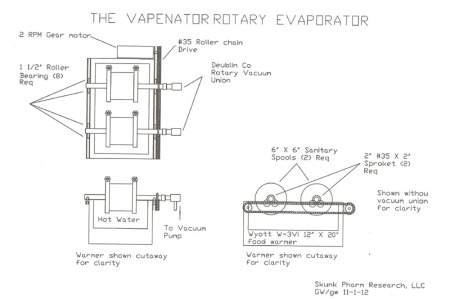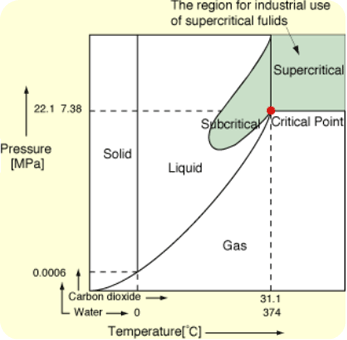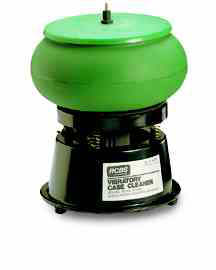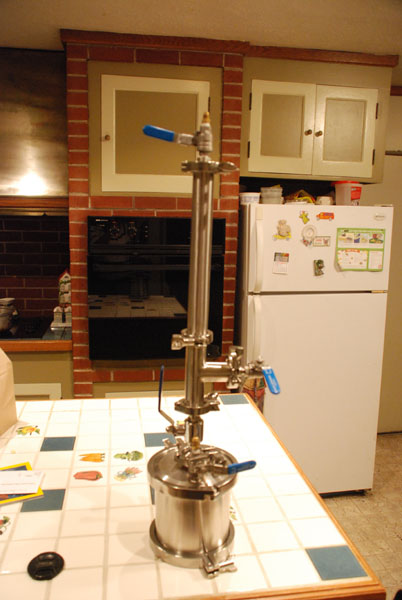What deep dark alchemist lair is complete without a rotary evaporator, but how many of us'n poor brothers or sisters can afford one?
How nice a Rotovape looks, but hard to clean, besides expensive. Hee, hee, hee, let's see what we can do better, cheaper?
Behold the Evapanator rotary thin film evaporator, in next years prototype build schedule.
The Mk I Vapenator uses twin drums constructed from 6" X 6" stainless steel sanitary couplings from Glacier Tank. The clamped on lids are modified to include a hollow shaft, which allows the drums to be rotated on their sides in a hot water or oil bath, while a vacuum is being pulled on them, through a rotary vacuum union.
The hot water bath can handily be provided by a 1200W Wyott W-3Vi 12" X 20" counter top food warmer, and Deublin Co can provide a suitable 17-051-045 rotary vacuum union.
The shafts through the lids rest in a vee between two 1 1/2" roller bearings and a 2" X 15 tooth #35 sprocket rests on a moving roller chain, powered by a 2 rpm gear motor.
Still checking specs and prices for the gear motor and trying to decide on the incremental utility of a variable speed gear motor, vis a vis fixed ~2 rpm unit, giving the drum about 1.6 sq/ft of thin film evaporative surface per minute under vacuum, per drum. I may jury rig the first unit with a variable speed motor, to determine optimum speed.
The cool thang, is that you just disconnect the vacuum hose, and the whole drum assemblies just lift out.
Cooler yet, is both ends of the drum come off via 6" Tri-clamps, which gives full access to the inside of the stainless drum, to clean out the viscous resins.
Here is my conceptual of the purdy thang! For those of ya'll who understand it at a glance and are off to do it one better, ah hope you will share. For those with patience enough to wait for it's schedule in the queue, watch this space for detailed drawings and our own prototype shake down.







So, i can use directly the gathering unit of terpp mkIII to purging the extract?
I just bought a truck load of used rotavaps from Merk and got a pretty good deal. I've sold one on eBay to Purdue and one to a friend. I'm not sure what I'm going to do with the rest. If anybody's interested I could list on eBay. I would like for them to get into the hands of people that are going to help others rather than make flavors for their vodka. The rotavaps really aren't that hard to clean just put some solvent back in and spin with no heat to clean the flask.
How much? What are the operating parameters or how long does it take to recover a liter of alcohol at 95f ?
I've been selling them for $1150 which includes shipping. I can sell it for 1000 if the buyer pays shipping. I let the people at FedEx pack it last time and it cost me $90 in all. As far as the parameters go.I'm not too sure. I have a couple different models. They're all made by Buchi. I'll need to look and see what I have left but I know is I have some r114 and r124 and they come with water baths. I think they all go to 100°C. As far as the condensers go, all I have left are cold trap condensers that need dry ice to work and I haven't used any of thoes yet. All I've used are the diagonal spiral condensers with cold water running through. I use the lowest temperature required to evaporate the solvent... I didn't get up to 95f last time and wasn't using alcohol. My memory may be off a little...I think it took me about 4-5 hours to do 4 liters. I took my time but it could be done faster just by standing there being ready to add more solution.
Hi I'm interested in the rotovap. How can I contact u ? (Thanks Joe)
Sure you can email me at md4890@yahoo.com and we can go from there. Thanks.
I am interested. I have a very sick wife and need to make medicine for her Alozment@aol.com
I am very interested in purchasing one from you.
I would love to get my hands on a used one at a decent price .. Let me know ! Thanks
I would like to buy your roto vap.
I want to make a concentrate out of a tea I make for plants, will this work?
Kirk- Thank you for this excellent resource! I have a WordPress book as reference, but while it explains the ha6;w28t’, it often fails to explain the ‘how.’ Every video of yours I have watched so far has thoroughly explained and shown what I needed to learn. Nice work!
I am interested in a used Roto
i'm thinking a larger design could easily be fabricated from discarded beer or soda (which are rated for 110PSI typically) kegs with 8" sanitary flanges welded in place of the sanke valve fitting to allow cleaning/sanitization and removal of product
[…] Several lifetimes ago, Greywolf a well known wizzard, posted a challenge @ http://skunkpharmresearch.com/the-evapanator-rotary-thin-film-evaporator/ He said and I quote, “Here is my conceptual of the purdy thang! For those of ya’ll who […]
Inspired by the challenge, I went into the shop for a year and came out with this! The Rotovap Maximus, will recover 1 liter of alcohol in 4 hours. https://www.facebook.com/rotovapmaximus
Can someone Explain to how this Prototype works? Really Need it . . Tnx
can someone please explain to me how this prototype work? really Need it . . . Tnx
The next step would be to make a WFEP Wpied film evaporator
I use a large triangular stirbar in my 6" vessel on top of a magnetic stirrer/hotplate with an oilslick mat to keep it from moving too much, at about 200 degrees. I put that under constant vacuum, alternating between storage in a freezer and out to lock up the extract and disable the purged gasses from re-entering it. I cut my purge times down dramatically. You need a kickass vacuum, since it's on almost the entire time. I used to use thin film under vac, but when I moved up in volume I was forced by logistics to come up with a faster method of purging. I call it rapid-purging. Stirbar: XL-SBM-13636-TRI TRIANGULAR Sibgene.com has decent magentic stirrers.
Be careful with the acrylic as it will crack. thats the beauty of polycarbonate. If you take a thinner piece of each and attempt to bend them both; the acrylic will crack when you bend it and the polycarbonate will only bend to a full 180 degrees and then return. Granted with a smaller diameter chamber it doesnt matter that much. Also try using a rubber industrial vacuum cup to attach to your top. the threads with the forces of full vacuum upon it only weaken the plastic top... and also cause a potential leak considering the connection is to plastic. ESPECIALLY if the hole is in the middle where the top sees the most flex. the hole close to the edge is ideal IMO. My 2 pennies... :)
so you are just using the buna gasket from the terpenator to seal between the terp and the plastic?
Yes.
I like it. Simple and nice. If a 12" diameter pot was used how thick would the acrylic have to be?
About 1 /14 to 1 1/2" thick. Our 1" acrylic panel still bows 1/6" under full vacuum. Some flex is OK, but we are also using heat and eventually high cyclic fatigue is likely to result in stress cracks, leading to eventual failure. Heat significantly lowers the properties of acrylics and polycarbonates, so I design to the heavy end and we are currently using 1 1/2" Polycarbonate for our 12" vacuum chamber, but continue to use the 1" panel for the 10" Mk I & II Terpenators.
Hiya Graywolf! Hey after attending the alchemy class... I remember hearing that glacier tank had 12 inch spools coming in.... My thoughts were to build ONE drum instead of 2 What would be the difference in a 12 inch spool and 2 6inch spools as far as surface space? If we used 1 12inch it would save money on parts .....
I designed it with two drums because I had space for two. I only have room for one in the used bain marie that I picked up for the prototype, but they can be built any size and with as many drums as you have space for.
Hiya Jd.... Was thinking about trying to build a Low heat, high vacuum, high production alcohol purging cabinet and could use your help and advice... This is all in the thought process still, but I do have a world class fabricator here so If I can come up with the right design he can put it together for me... So What I was thinking was getting this: http://www.webstaurantstore.com/half-height-bun-pan-rack-mobile-end-load-unassembled-10-pan-capacity/600PR103K.html Somehow sealing the whole thing up, and adding whatever additional bracing we may require. And then adding an in line fan, and a vacuum fitting (Possibly a dedicated vacuum for this unit.) There are several problems that need to be addressed.... Obviously the fan and the vacuum cannot be run at the same time, but the goal is is to keep the cabinet between 75 Degrees and 130 degrees Possibly separating this into 2 sections or over multiple with a switch We might even have some 1 inch thick on both front doors to see whats going on with the tray. This would allow for us to reduce the time required in purging large amounts of 190 Proof Ethanol from Fully Winterized Absolute Shatter using your thin layer low/no heat method. What I am picturing is a vacuum Chamber that I can put Restaurant Style Cake/Baking sheets into with the resin already spread thin.... that holds temperature at low temperatures, that I can vacuum under a hard vac for 15 minutes and be done.... Any advice/suggestions/collaboration ideas?
and for the record.... the oil would be on parchment paper on the baking pan for easy cleaning What I need (and everyone making absolute shatter ) is a way to get a vacuum on a larger area... so I could put thin layers to be purged, with a WAY larger surface area than the petri dish in my dessicator with a heat plate.
The reason I dont need to go stainless and all fancy is the resin will only touch the parchment paper....
If we did make it into 2 sections the bottom could be the vacuum and the top could hold 4 racks with the in line fan blowing through a filter... to do final drying.... :-)
Kind of combining Large surface Drying and Large surface vacuum in the same unit... only on steroids... Skunk Pharms Multi Finish and Polishing vacuum Drying unit. COMMERCIAL (Or something you in your infinite wisdom can think of relating to terping and evapping LOLZ "Shattercabinet")
You might consider a vacuum oven off E-bay.
Most of them are not big enough.... what I need is something that will purge a cake sheet or half a cake sheet
If I understand you correctly, you are proposing a rack of rotary drums under vacuum, in a temperature controled enclosure. I would think such a design would work. The heat from a hot air oven won't transfer as fast as with an emmersion bath, and boiling under vacuum will produce some refrigeration, so not sure about the overall efficiency.
I can already see how this is going to be an awesome addition to the lab. Can I be first on the list to get one of these when you start making them?
Thanks for the good thoughts bro! Skunk Pharm Research makes no products for sale, but Specialized Formulations might make one for you.
This is absolutely brilliant! Would you mind if I attempted to build your design and try it out.
Thanks for the good thoughts and please do build as many as you like! That was the whole reason from sharing the design. Bon appetite! GW
Hey, Anonymousgrow, Any luck on that build?